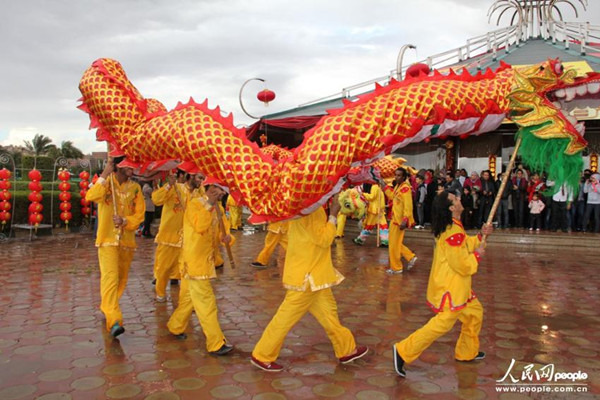The Chinese New Year - Just Share It contest provided a chance for participants from all over the world to tell their stories of the Spring Festival. We received entries from across the globe and are pleased to show these original works –stories, photos and videos– on our website. After a grueling selection process and tough discussions, we have shortlisted the potential winners. Some of the submissions have been edited for style and context.
To select the winners, we invite you to choose the best contributions made by fellow readers. Although a minimum of three works will be shortlisted, but you can pick more. Help us share and spread the beauty of Chinese New Year to the world. You can find out more about voting details here.
Egypt feels the fresh breeze of Chinese Spring Festival
Updated: 2015-03-11 15:49
 |
|
[Photo/People.cn] |
By Nermin Edward Nakhla
As colorful and joyful as usual, the Chinese community in Egypt celebrated the Lunar New Year, commonly known as Spring Festival, on Friday at Maadi Island Park in the capital city of Cairo. Nearly 8,000 Egyptian and Chinese attended, including children, youth and the families of Chinese and Egyptians. Journalists and correspondents from the Egyptian and Chinese media and Chinese diplomats, politicians, and businessmen joined them.
Surrounded by the River Nile, the entrance to the park was ornamented with large red signs welcoming the visitors and wishing them a happy Lunar New Year. Red balloons and lanterns were hanging on trees all over the park, some of which were later given to children as gifts. A traditional band dressed in red and yellow received the visitors at the entrance with Chinese dragon dances and drum beats to mark the beginning of the joyful event.
During the event, a number of stage performers got the audience to interact with cheers and smiles, such as the Chinese Folk Arts performance, which included various shows and famous Arab and Chinese music. Next came hip hop, which attracted the attention of all, especially the youth. There were also nearly 40 stalls of traditional Chinese handcrafts art such as paper-cuts, Chinese kites, the art of shadow puppets, drawing with sugar, Chinese tea and Chinese calligraphy.
The most astonishing art for me was drawing portraits using colorful powders, in which the art maker was brilliant and very accurate in detailing the faces and colors. The festival also presented quizzes, puzzles and fun games for all ages.
2015 is the Year of the Sheep, so those who were born in this year received gifts. The attendees also enjoyed Chinese food. Everyone was joyfully taking photos.
I came with my brother and my friends for entertainment. I thoroughly enjoyed the performances and the celebratory atmosphere of the Spring Festival. I even met my friends from university. One of them is married to a Chinese man and has a half-Chinese, half-Egyptian baby. Her husband also asked me to search for a Chinese husband, so that day he introduced to me a Chinese man and his mother. I escaped in embarrassment.
The day demonstrated cultural interaction between the Chinese people and the Egyptian visitors and guests who filled the park and were overjoyed by the Asian and Egyptian traditional performances.
Spring Festival being one of the traditional Chinese festivals, it is the grandest and the most important festival for Chinese. It is also a time for family gatherings, similar to Christmas Day to Westerners.
There are many legends about the Spring Festival in Chinese culture. In folk culture, it is also called “guonian” (meaning “passing a year”). It is said that the “nian” (year) was a strong monster that was fierce and cruel and ate one kind of animal, including human beings, a day. Human beings were horrified and had to hide in the evening when the “nian” came out. Later, people found that “nian” itself fears the color red and fireworks. So after that, people used red colors and fireworks or firecrackers to drive away “nian”. As a result, the custom of using red and setting off fireworks remains.
All the door panels will be pasted with Spring Festival couplets. The Chinese character "fu" (meaning blessing or happiness) is a must.
I work at Xinhua News Agency, so naturally we celebrated. On Feb 18 at 6 pm, they ate jiaozi, or dumplings, as the sound "jiaozi" resembles the word for "bidding farewell to the old and ushering in the new". Also, the shape of the dumpling is like a gold ingot from ancient China. People eat them and wish for money and treasure. Then our party program started. It was funny and amazed us. Some coworkers sang Chinese and English songs, danced, read poetry and played games.
Now in Egypt, Spring Festival has attracted great attention: the Ministry of Tourism has organized celebrations of Chinese New Year in several places in Cairo like Baron Palace, the Mena House Hotel and Citadel of Saladin. Many important personalities take part in these celebrations, such as Tourism Minister Hesham Zaazou and China’s ambassador to Egypt.
The event was organized by the Chinese Cultural Center and the Chinese embassy in Cairo, under the auspices of Egypt's ministries of Culture and Tourism.
Over the past five years, the Chinese Lunar New Year celebrations were held at Maadi Island, Al-Azhar Park, Rehab City and El Sawy Culture Wheel in Cairo, attracting more Egyptian visitors every year as a clear sign of cultural interaction between the two civilizations.
The 2015 Spring Festival witnessed more Egyptian visitors and more stability in Egypt than last year, reaffirming the deep-rooted friendship between the Chinese and the Egyptian peoples.
Media Support: | Chinadaily.com.cn | Ecns.cn | People's Daily Online | xinhua.net | |China.org.cn | |cntv.com | |CRI.cn |
